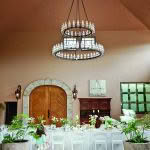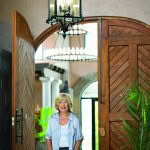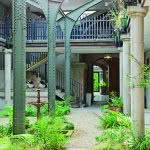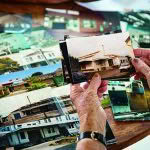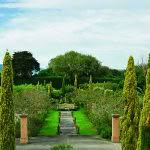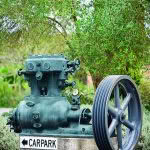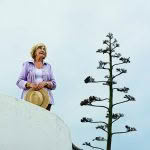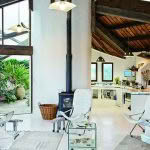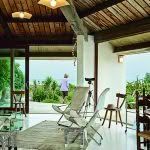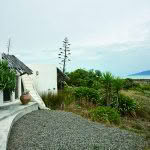A derelict milk station transformed into a beloved Otaki venue
- The Milk Station set up for a wedding. Photo: Jenny Siaosi
- Lyndia Wood stands in an arch doorway she had carved into The Milk Station’s concrete walls. The doors – which had been stored in Lyndia’s antique-filled garage waiting reuse – were rectangular but she had a curved top added to suit her vision.
- While Lyndia changed the interior of The Milk Station beyond recognition, including creating a central courtyard, it all had to fit around the building’s original steel structure.
- Lyndia admits she may not have taken on The Milk Station had she known the scale of its renovation from a deserted beast into a Mediterranean-inspired beauty. Wherever possible she has reused materials from the old factory (and furnished it with gorgeous antiques saved from her previous profession).
- Planting the formal garden at The Milk Station was the first thing Lyndia did. She also planted numerous fruit trees, which she picks herself.
- The sprawling gardens at The Milk Station
- An old compressor excavated from the factory has a new life as garden art at The Milk Station.
- Lyndia stands on one of the view-rich decks of her beach house in Te Horo. The decks are formed from the flat bedroom roofs, reached by the house’s curved external staircase.
- The living room of Lyndia’s beach house is built around a central pillar that supports the house’s various levels of roof. The kitchen curves cleverly around the pillar, ending with a pantry tucked inside. Vast sliding doors make up three sides of the hexagon, which can be slid back – or closed tight to shut out a stiff westerly.
- “The idea for the Te Horo house was from Mauritius, from a hotel with white walls and floors and a thatched roof. I also loved the hexagonal part of a restaurant in London’s Hyde Park.,” says Lyndia.
- The white walls and thatched roof of a hotel in Mauritius inspired Lyndia’s 30-year-old beach house. “My parents had a bach at Raumati, so I’m very used to this coast,” she says. “I like the sea, I’m very much a sea person.”
From dairy lab technician to milk station owner by way of antique expert, Lyndia Wood’s life and times has taken many turns
Words: Lee-Anne Duncan
Photos: Tessa Chrisp
The gravel driveway leading to Lyndia Wood’s Te Horo beach house could be a topographic map of her life. It loops past exotics and natives and up over hillocks that hide the house until her happy place is finally revealed, crisply white against the Kapiti seascape.
The three-bedroom retreat is as distinct as its owner. Lyndia and her late husband Peter bought the seafront land more than 30 years ago. They stayed in a caravan until the house – its style inspired by a hotel in Mauritius and designed by Wellington architect Fritz Eisenhofer – was constructed.
Lyndia had travelled to the Indian Ocean island off the south-eastern coast of Africa, past Madagascar, with Peter on wool-supplying business trips. Peter’s Yorkshireman father started Woolyarns in Lower Hutt nearly 50 years ago and the family still owns the business. “It’s been going for 50 years now. I go out and do the gardens, talk to the general manager. You know, show a family face.”
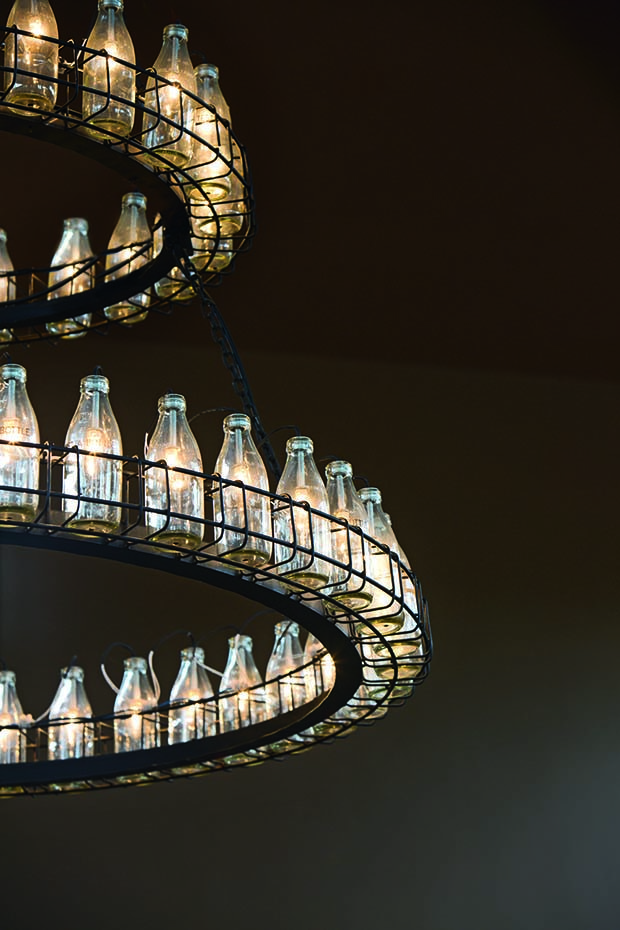
The candelabra was designed by Lyndia and her late husband Peter and built by local engineers.
But Lyndia is no hausfrau following her husband to and fro. Now in her seventies she’s traversed a full life of many careers, the first for the Dairy Board.
“When I finished school I wanted to be independent and work. I’d always been good at mathematics so I got a job calculating test sheets for the Dairy Board statistician. In those days farmers were paid by the percentage of butterfat in the milk. Then I transferred as a lab technician to the Animal Health Laboratory at Ruakura in Hamilton.”
That transfer was brief as she was due to be married to Peter. She returned to her home town of Wellington and set up house in the Hutt Valley, doing the books for Peter’s business. “I was good at maths but I was no accountant,” she says.
Then, with two small children (Tracy, now a lawyer who breeds galloway cattle at her Warkworth farmstay and retreat, and Nicola, an accountant married to Norbert who manages The Milk Station), she got into modelling, even winning a competition in 1969.
“I was a ballet dancer and they often ended up modelling. So I took a course, then did photographic and runway modelling. I’d walk in the James Smith parades twice a year at the Winter Showgrounds, and the Benson & Hedges Fashion Awards. I did it into my 30s and had a great time. I was interested in fashion. I loved sewing, and I’d make my clothes and those of the girls.”
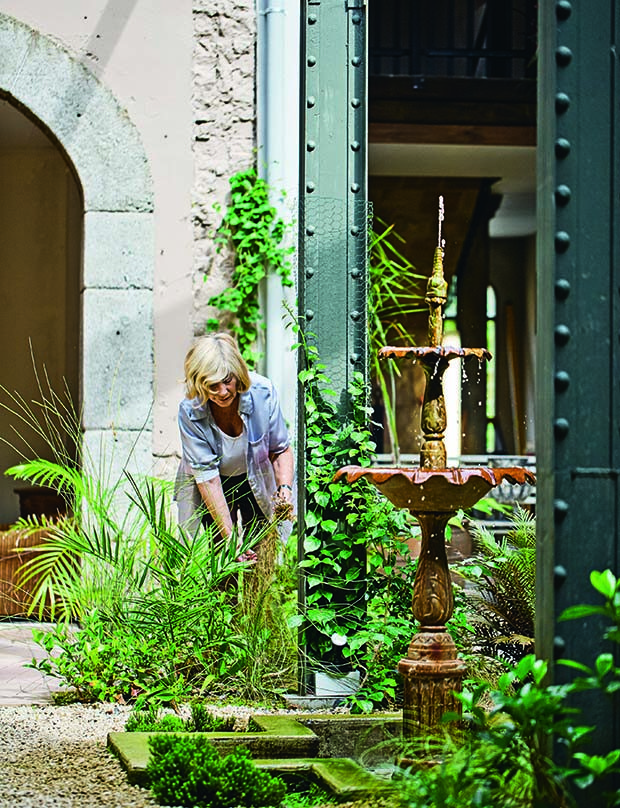
The courtyard of The Milk Station.
Soon her interest turned to antiques, the next career that continues to play in the life of this softly spoken but clearly determined woman.
“I used to go to antique auctions with a friend and got quite interested. We had built a new house at the top of Stokes Valley so I had the opportunity to decorate. I found I liked the combination of antiques and modern furniture, which was then mid-century furniture.”
Her first steps at turning that interest into a profession were taken in a small shop in Waikanae. “It was half a shop, really, with a hairdresser in the back. I opened it because my mother needed something to do, so she’d mind the shop during the week, then I’d come up on Saturday. To open up in Wellington would have been nerve-wracking. Waikanae gave me the chance to try it.”
Two years later, with her mother relocated to Auckland, Lyndia opened her first antique store in the capital – initially in upper Willis Street, then in a building she purchased in Thorndon Quay. “I’d go to London and buy antiques by the container. I’d buy them in rough condition and restore them. It was harder to get quality antiques in those days, so this was the best way to build up my stock. New Zealanders liked practical furniture – chests of drawers, chairs, tables. Anything unusual or too fancy was difficult to sell back then.”
The antiques career overlapped with Lyndia’s next and latest – property developer. She financed the Thorndon Quay building from the redevelopment of a church hall in Breaker Bay, then bought two residential projects elsewhere in Thorndon. But those projects were a mere primer for her most recent and most challenging – a massive reconstruction and renovation effort in Otaki.
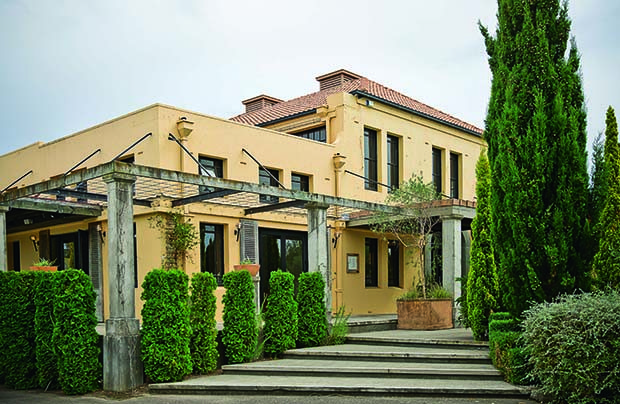
The exterior of the function room at The Milk Station.
A derelict old milk station has now been capitalized into The Milk Station. It’s a Mediterranean-inspired function centre, with gardens grown for romance and 26-room accommodation so guests can settle in for a good time. “All this? It’s all Lyndia,” says Lyndia’s son-in-law Norbert Koptisch, who manages the property day to day. “Every paint colour, every tree, every door handle – she’s chosen and envisaged everything.”
Lyndia became the owner 10 years ago, and spent the next six turning the 1926 Grade II Historic Place-listed concrete building from a deserted, unloved wreck into something beloved by the betrothed.
“I’d always admired the building driving past, seeing it from the road,” Lyndia says. “I liked its style, its architecture. By chance I saw it was up for tender. Two days before the tender closed I called the estate agent and had a talk and a walk through. I told them to let me know if it didn’t sell. It didn’t, so I bought it.”
Lyndia admits she’d bought herself unforeseen challenges. It took her the best part of three years just to clean out what had been left behind. “It was as if the last owners had walked out and just left everything. There was a lot of old machinery and plant, bottles, even papers left on desks. “Unfortunately we also discovered two underground oil tanks that had to be dug up. And we had to take out a wall to get one of the bigger bottling machines out.” Some machinery she’s hung onto – one is now a sculpture in the driveway, others are in storage waiting for her to work out how best to use them.
Inspiration for her vision took some time to solidify. “Originally I thought I’d make it into a market. But the building was too good – it looked like a lodge or a hotel. We didn’t plan to do weddings, but we started getting approaches even before the building was finished.”
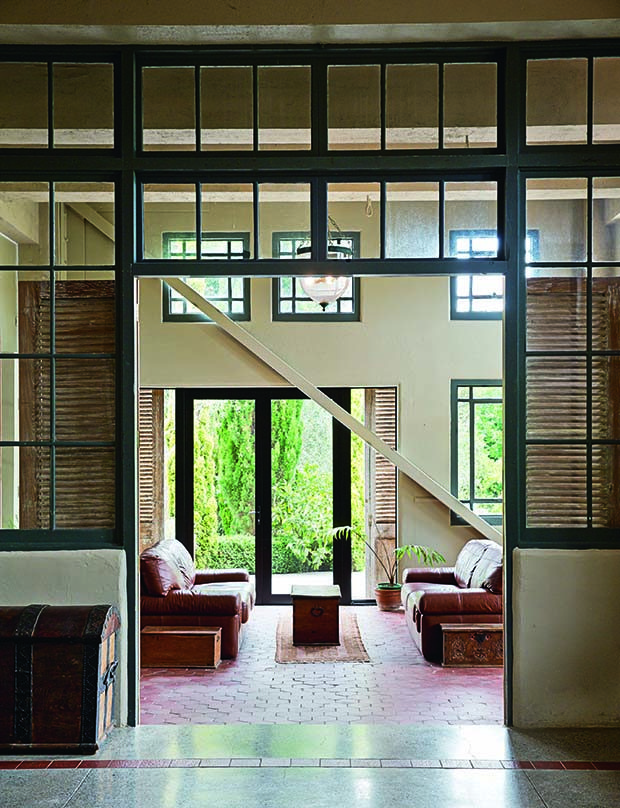
Wherever possible she has reused materials from the old factory (and furnished it with gorgeous antiques saved from her previous profession).
With asbestos removed, concrete floors cut through, a central wall taken out, a fire during construction endured (awelding spark ignited birds’ nests in the roof), decks erected and stairs installed, The Milk Station was fully open. Every wall, corner, floor tile, paint colour, duvet cover, fruit tree, faucet and flourish was personally selected and seen to by Lyndia. She didn’t use an architect, just a really good local builder – Gordon Hansen, who also built her Te Horo beach house.
“I couldn’t have anyone help me as I’m the only person who knows what effect I’m trying to achieve. I rely on my eye a lot, and my sense of balance and proportion,” she says. “Since Gordon and I had worked together, we understand each other. I’d tell him what I wanted and, although my instructions can be a bit vague, he’d deliver.”
The first official wedding, in April 2011, was that of Norbert and Lyndia’s daughter, Nicola. Now the venue’s a nuptial favourite.
“We’ve never had rain on a wedding day,” says Norbert, bravely tempting fate. Most weddings take place around the pond created with slabs of concrete recycled from the factory. “I wanted to make it into a lily pond, but the pukeko kept eating them,” Lyndia smiles.
The swamp birds present possibly the renovation’s smallest challenge and Lyndia admits she may not have taken it on had she known its scale. “I didn’t realize how much was involved with the machinery, changing the floor levels and all,” she says. “There was so much I couldn’t see until I got into it. It was a bit of a minefield, really, and that’s an understatement. But stopping isn’t in my vocabulary. I don’t want to stop. I like to be creative. I need to have a challenge and I love to be making something.”
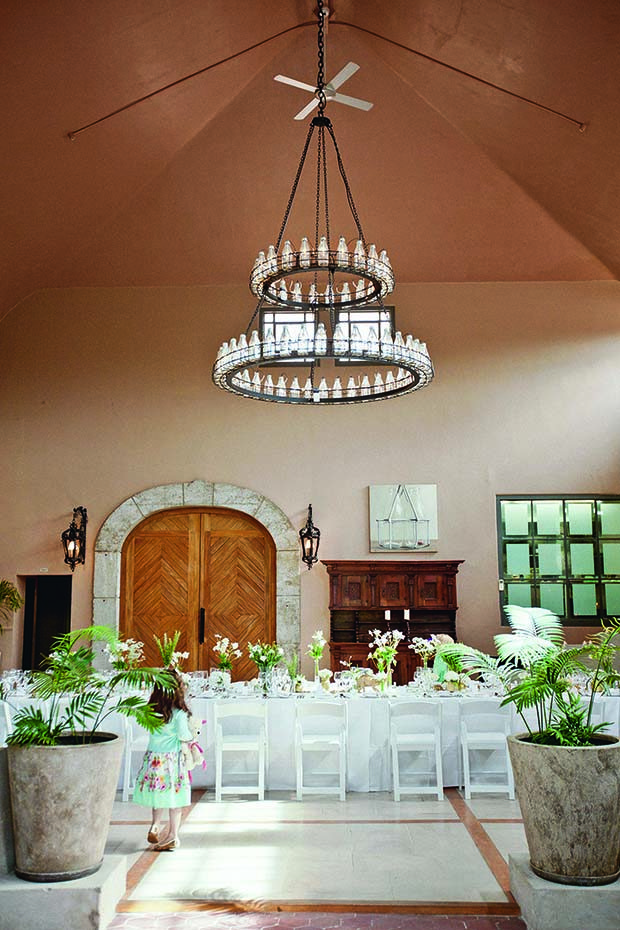
“We didn’t plan to do weddings, but we started getting approaches even before the building was finished,” says Lyndia. Photo Jenny Siaso.
With The Milk Station largely complete – although, with Lyndia’s ever-expanding vision it may never be truly finished – and her last antique business sold in 2013, she’s turned her eye back to her Te Horo house. Landscaper Peter Bishop has been in the garden, giving the four-hectare garden an overdue makeover. “Now Otaki’s done, and I’m by myself, it gives me added interest to recreate the landscaping, and it adds to the house,” she says.
“I know everyone’s planting natives these days but I’m into Mediterranean plants. The style of the house suits that. I love cacti and I’d like to grow some exotic things, maybe pineapples. Fritz [Eisenhofer] was here recently and said the new landscaping is integrating the house into the surroundings so much better.”
Whatever she plants it will have to be fairly self-sufficient as Lyndia still spends a good half of her life in Wellington. “I like the contrast. I like the city, I like Wellington, and I love being near the sea. But I don’t think I could live up here on the coast full time. I can’t see myself giving up the city for the quiet life.”
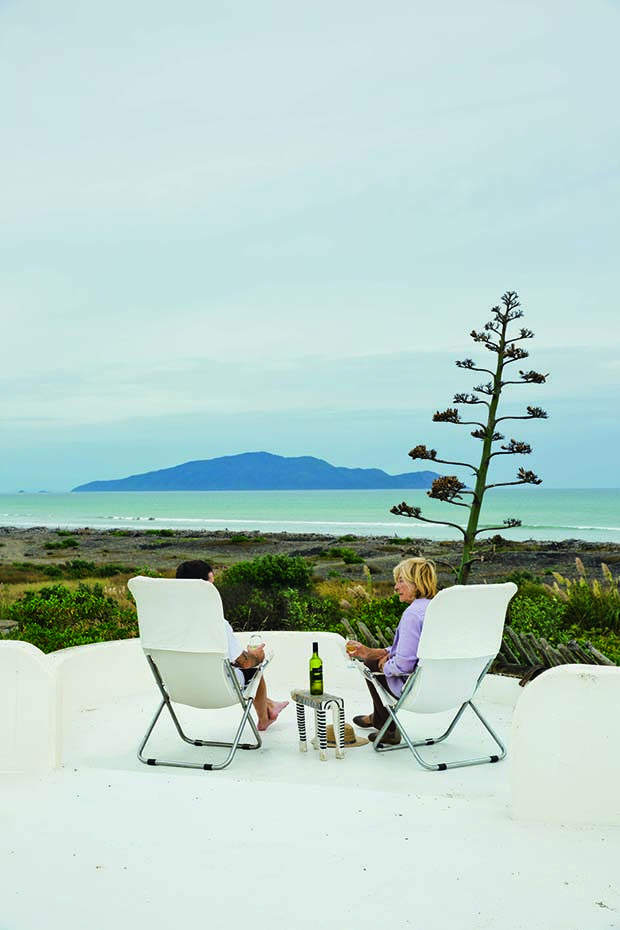
Lyndia at her beach house in Te Horo.
BUILDING AT THE BEACH
While Lyndia Wood created The Milk Station without the help of an architect, she employed renown architect Fritz Eisenhofer for her Te Horo house. The two-bedroom plus guest house is constructed from concrete blocks and finished in plaster.
Fritz, who in 2010 was named as an Officer of the New Zealand Order of Merit for services to architecture, was born in Austria and immigrated here in 1953 to build state houses. He’s known for designing highly modern homes, built for light and warmth and with a strong relationship to their surroundings.
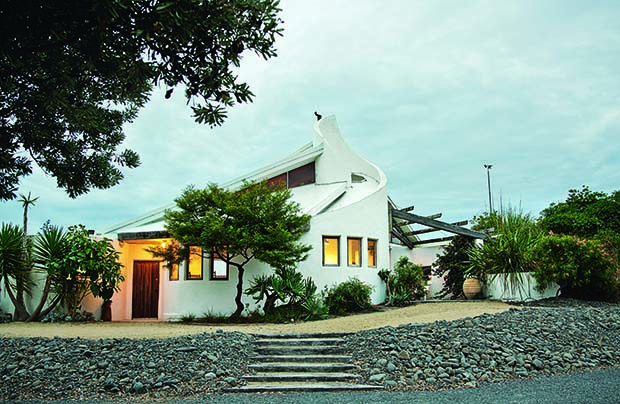
With The Milk Station all go, Lyndia’s creative vision has been turned back to her house. Bush and trees have been removed from around the house, exotics planted and haha-like terraces created to enable views while hiding areas Lyndia doesn’t want to see – car parks, for example.
Fritz now lives down the road in Peka Peka, where he’s built his own dome-shaped, solar-inspired home. “The idea for the Te Horo house was from Mauritius, from a hotel with white walls and floors and a thatched roof. I also loved the hexagonal part of a restaurant in London’s Hyde Park. I just said to Fritz I wanted these things, and for the living area to have a tent-like roof and the bedrooms to have contrasting flat roofs we could walk on. Fritz brought his own interpretation to it, which was much more architectural than I would have thought possible.”
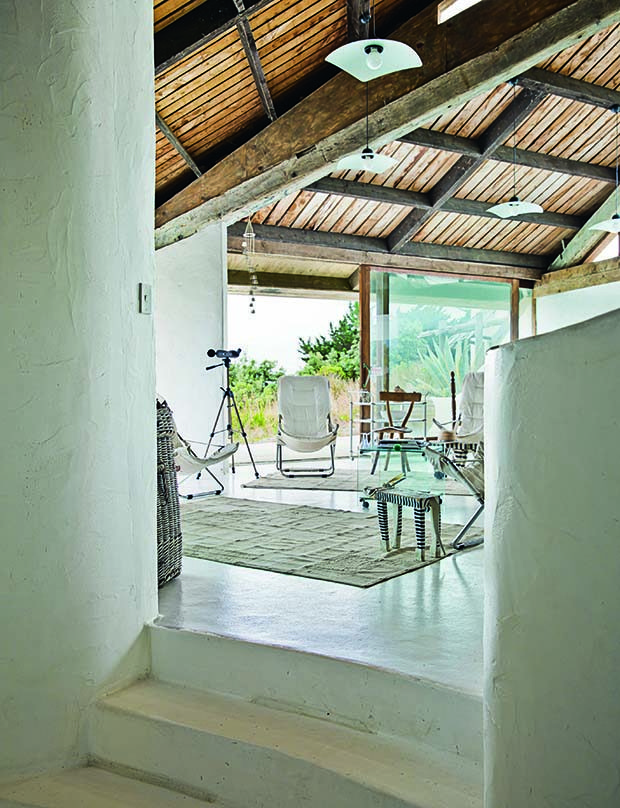
Along with white walls and white floors, Lyndia’s brief to architect Fritz Eisenhofer included a hexagonal living area, which allows for an encompassing sea view. The exposed ceiling timbers were also her idea. “Fritz was planning a match-lined ceiling but I wanted the timbers kept exposed, to be more rustic. I didn’t want it to be too perfect.” The animal stool/coffee table Lyndia bought in from Bali. “I occasionally imported a container of furniture from there – more novelty furniture than antiques.”
As someone who has her own very definite vision for a building project, Lyndia admits it was hard to stay out of Fritz’s way. “We’re good friends but I can understand that he found it frustrating to work with me. I get ideas – I know what I want but I can’t always explain it.”
One idea Fritz used to his advantage resulted in the house’s snow-like swirl. “He was looking for a design to fit different levels of roof onto a central column. I’d always loved the spiral he created at the Pukerua Bay Crematorium so I said I didn’t mind if he copied that look. And it worked.”
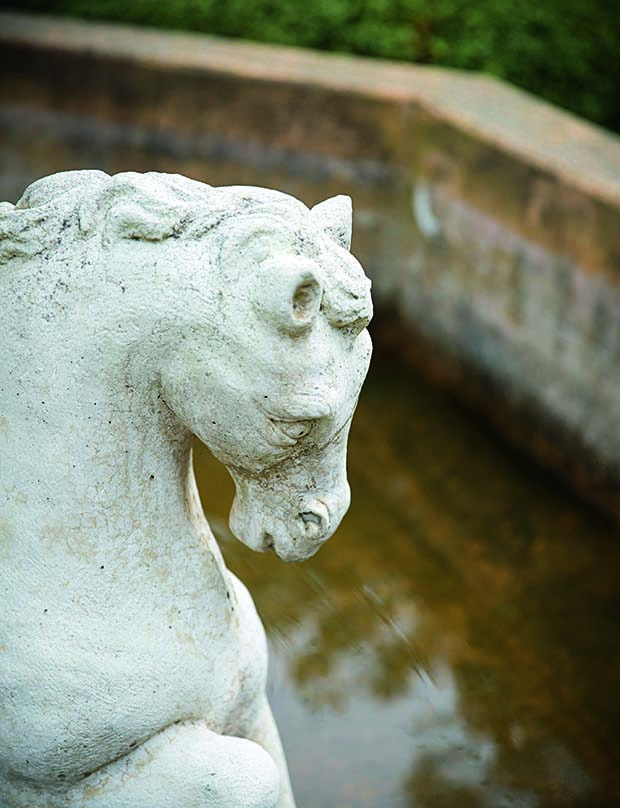
LYNDIA’S ANTIQUE TIPS:
After 40 years’ dealing and restoring antiques (mostly of the eras spanning 1700 to 1900), Lyndia knows her way around furniture and is happy to share her top tips.
✚ Go for classic styles – Lyndia prefers Georgian and Edwardian to Victorian.
✚ The more valuable a piece of furniture, the less it should be restored. Resist the temptation to make something perfect.
✚ Look for something with a good patina – a build up on the wood that tells the furniture’s story.
✚ Never sand furniture as that takes it back to new wood. Use paint stripper – very carefully.
✚ Never use a silicon polish as it hardens into an ugly layer. Beeswax
is best.
✚ DIY restoration? It depends on how valuable it is. If it’s worth a pretty penny, spend a few more on an expert.
✚ Mix antique and modern. Lyndia finds the contrast “exciting – so long as you get the balance right”.
